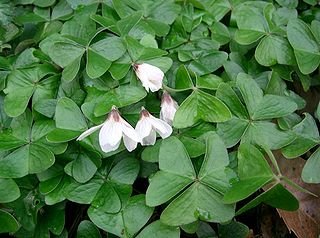
Oxalis or is a large genus of flowering plants in the wood-sorrel family Oxalidaceae, comprising about 570 species. The genus occurs throughout most of the world, except for the polar areas; species diversity is particularly rich in tropical Brazil, Mexico and South Africa.

Melastomataceae is a family of dicotyledonous flowering plants found mostly in the tropics comprising c. 165 genera and c. 5115 known species. Melastomes are annual or perennial herbs, shrubs, or small trees.

Tibouchina Aubl. is a neotropical flowering plant genus in Melastomataceae Juss. that contains approximately 240 species. Species of this genus are herbs, shrubs or trees and typically have purple flowers. They are native to Mexico, the Caribbean, and South America where they are found as far south as northern Argentina. Members of this genus are known as glory bushes, glory trees or princess flowers. The name Tibouchina is adapted from a Guianan indigenous name for a member of this genus [2]. A recent systematic study has shown that this genus is paraphyletic.

Schinus terebinthifolia is a species of flowering plant in the cashew family, Anacardiaceae, that is native to subtropical and tropical South America. Common names include Brazilian peppertree, aroeira, rose pepper, broadleaved pepper tree, wilelaiki, Christmasberry tree and Florida holly. The species name has been very commonly misspelled as "terebinthifolius", due to considerable historic confusion as to the correct gender of the genus name; as of 2015 this has been resolved with the determination that the correct gender of Schinus is feminine, and adjectival names within the genus must be spelled accordingly.

Miconia is a genus of flowering plants in the glory bush family, Melastomataceae, native to warm temperate to tropical regions of the Americas. The species are mostly shrubs and small to medium-sized trees up to 15 m tall. The generic name honours Catalan physician and botanist Francesc Micó. Some species are known by the common name johnnyberry.

The southern muriqui is a muriqui species endemic to Brazil. It is found in the Brazilian states of Paraná, São Paulo, Rio de Janeiro, Espírito Santo and Minas Gerais. This New World monkey is known locally as mono carvoeiro, which translates to "charcoal monkey".

Melastoma affine, also known by the common names blue tongue or native lassiandra, is a shrub of the family Melastomataceae. Distributed in tropical and sub-tropical forests of India, South-east Asia and Australia, it is a plant of rainforest margins. Bees are the principal pollinators of this species.

Thismia is a genus of myco-heterotrophic plants in family Burmanniaceae, first described as a genus in 1845. It is native to East and Southeast Asia, New Guinea, Australia, New Zealand, and the Americas.
Xenurolebias is a genus of fish in the family Rivulidae. These annual killifish are endemic to temporary pools in the Atlantic forest near the coast in southeast Bahia and Espírito Santo, Brazil.
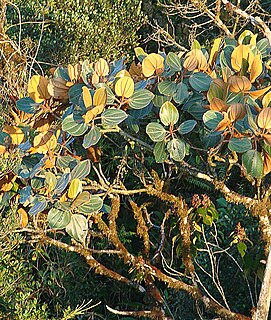
Graffenrieda is a genus of flowering plants in the family Melastomataceae. There are about 44 species. Most occur in South America. A few are distributed in Mexico, Central America and the Caribbean.

Tulista minima is a species of succulent plant, from the far south of the Western Cape, South Africa.

Miconia albicans is a species of shrub in the family Melastomataceae. It is known as "canela de velho" in Brazilian Portuguese. It is native to North and South America.

Miconia lacera is a species of shrub in the family Melastomataceae. It is native to North and South America.
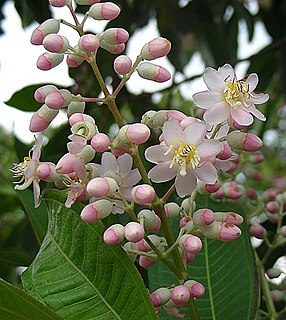
Miconia theaezans is a species of shrub or tree in the family Melastomataceae. It is native to South America.

Miconia ciliata is a species of shrub in the family Melastomataceae. It is native to North and South America.
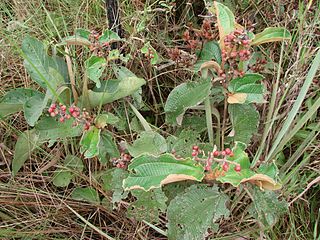
Miconia macrothyrsa is a species of shrub in the family Melastomataceae. It is native to South America.
Fritzschia is a genus of flowering plants in the family Melastomataceae, native to the Atlantic coastal forest of Brazil. They are sprawling or erect shrubs, with their branchlets and their hypanthia coated with either glandular or villose trichomes.
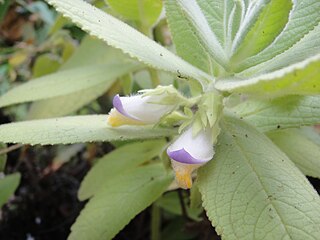
Isabelcristinia is a genus of shrubs in the family Linderniaceae containing a single species, Isabelcristinia aromatica. It grows on rocky outcrops called inselbergs in north-eastern Brazil in the state of Pernambuco. It has upright branches with gland-covered leaves that are aromatic to the touch. It has bilaboate flowers with a yellow lower and a pink upper lip and is likely pollinated by large bees. The genus is closely related to Ameroglossum, which is found in similar habitats but has flowers pollinated by hummingbirds.
Myrciaria alta is a species of plant in the family Myrtaceae, endemic to Espírito Santo, Brazil. It was first described in 2019 and it is closely related to Myrciaria glomerata.
Myrcia subterminalis is a species of plant in the family Myrtaceae, endemic to the east of Brazil, and first described in 2015.









